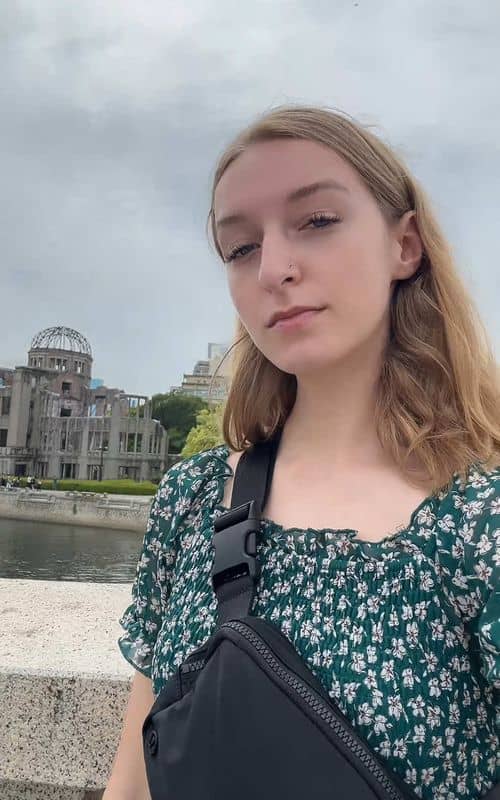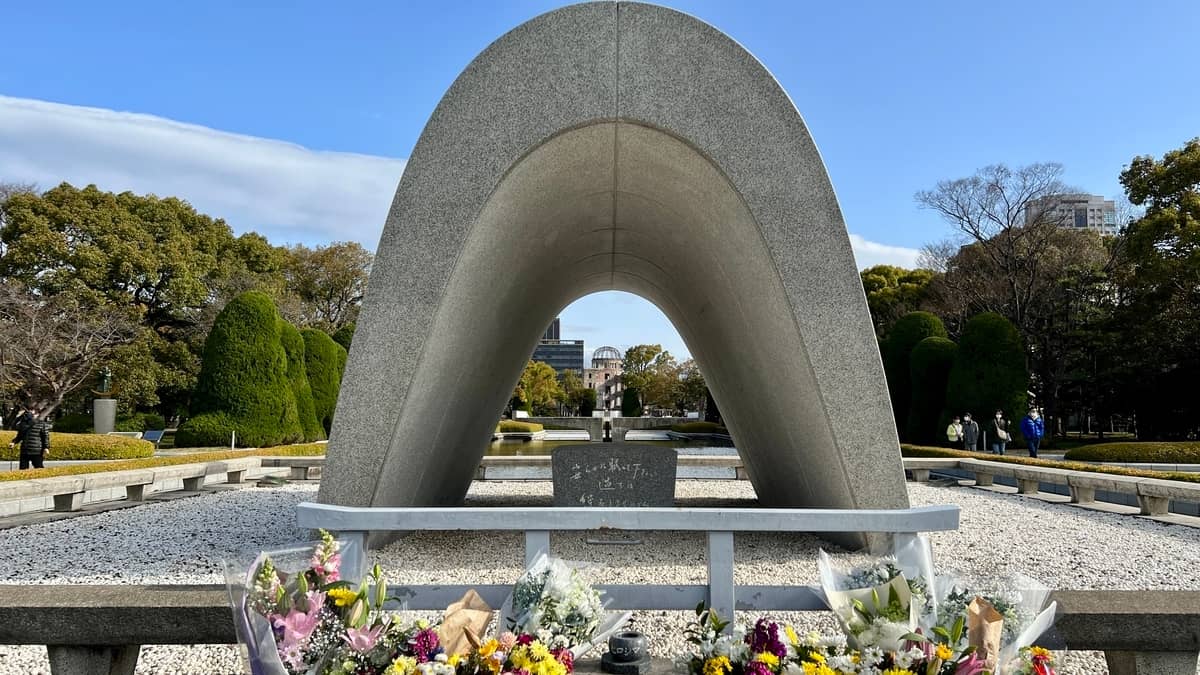Motoyasu River Promenade Hiroshima
A serene promenade along the Motoyasu River, offering reflective views of the Atomic Bomb Dome and the historic Motoyasu Bridge.

Highlights
Must-see attractions

Social
From TikTok & Reddit
Best Time
Commemorative events
Motoyasu River Promenade Hiroshima
Best Time
Commemorative events

Highlights
Must-see attractions
A serene promenade along the Motoyasu River, offering reflective views of the Atomic Bomb Dome and the historic Motoyasu Bridge.
"Crossing the Motoyasu Bridge is a significant and reflective experience, a stark reminder of devastation and resilience."
🚶♀️ Walk with Respect
This is a place for quiet reflection. Be mindful of others and the solemn atmosphere.
⚖️ Understand the History
Learn about the bridge's survival and its role in estimating the hypocenter.
Highlights
Discover the most iconic attractions and experiences

Motoyasu Bridge
Spans the Motoyasu River
A historic bridge that survived the atomic bombing, now a symbol of resilience and peace.
Atomic Bomb Dome View
Along the promenade
Unobstructed views of the iconic Atomic Bomb Dome, a UNESCO World Heritage site.

Peace Memorial Park Access
Connects to the park
The promenade serves as a gateway to the expansive Peace Memorial Park, offering a serene approach.
Plans like a pro.
Thinks like you
Planning Your Visit
Reflect and Remember
Timing Your Visit
Best Times
Insider Tips
from TikTok, Instagram & Reddit
🚶♀️ Walk with Respect
This is a place for quiet reflection. Be mindful of others and the solemn atmosphere.
⚖️ Understand the History
Learn about the bridge's survival and its role in estimating the hypocenter.
📸 Capture the Dome
The promenade offers excellent vantage points for photographing the Atomic Bomb Dome.
🕊️ Attend Memorials
If visiting on August 6th, witness the moving lantern releases for peace.
Tips
from all over the internet
🚶♀️ Walk with Respect
This is a place for quiet reflection. Be mindful of others and the solemn atmosphere.
⚖️ Understand the History
Learn about the bridge's survival and its role in estimating the hypocenter.
📸 Capture the Dome
The promenade offers excellent vantage points for photographing the Atomic Bomb Dome.
🕊️ Attend Memorials
If visiting on August 6th, witness the moving lantern releases for peace.
What Travellers Say
Reviews Summary
Visitors find the Motoyasu River Promenade to be a deeply moving and historically significant area, offering poignant views of the Atomic Bomb Dome and the resilient Motoyasu Bridge. It's a place that encourages quiet reflection on peace and remembrance, though the historical weight can be profound for some.
"A bridge that lots of tourists use
blast from the atomic bomb's explosion at 8:15 am, on August 6, 1945 struck the Motoyasu Bridge from above, pushing the capstones that covered its stone lanterns to either side and blowing the railings on both sides of the bridge outward, Chrowing them into the river below. The bridge itself was spared from colapse, becoming an important structure from which the precise location of the hypocenter was estimated. In 1992, the main and center pilars that withstood the bast were used to restore the present Motoyasu Bridge to recraate the origind 1926 desien. Two other A-bombed center pillars are also preserved here."
Jonathan Lim
"The original Motoyasu Bridge was built by Terumoto Mori when he built Hiroshima Castle and constructed the castle town 400 years ago. The bridge exposed to the atomic bombing was built in 1926. With spherical ornamental lights topping the main columns on both riverbanks and light posts lining the bridge itself, it was quite modern and stylish for its day. However, when the metal in the lighting fixtures was requisitioned for the war effort, lights were installed instead in stone lanterns."
Supakorn Jaroenwongtrakoon
"Crossing Motoyasu Bridge in Hiroshima is a significant and reflective experience. The bridge spans the Motoyasu River, leading directly to the Hiroshima Peace Memorial Park. As you walk across, you can see the iconic Atomic Bomb Dome on one side, a stark reminder of the devastation caused by the American atomic bombing of the city on August 6, 1945."
João Leitão
What People Like
What People Dislike
Frequently Asked Questions
🚇 🗺️ Getting There
The promenade is easily accessible by public transport. Take a tram to the 'Genbaku Dome-mae' (Atomic Bomb Dome) or 'Aioi-bashi' (Aioi Bridge) stop. From there, it's a short walk to the riverbanks.
While there isn't dedicated parking directly on the promenade, several paid parking lots are available near the Hiroshima Peace Memorial Park. It's often easier to use public transport.
It's a significant walk, about 30-40 minutes from Hiroshima Station. Taking a tram is highly recommended for convenience and to save time.
Tram lines 1, 2, or 6 will take you to the 'Genbaku Dome-mae' stop, which is right by the Atomic Bomb Dome and the start of the promenade.
Yes, the promenade is generally flat and paved, making it accessible for wheelchairs and strollers.
🎫 🎫 Tickets & Entry
No, the Motoyasu River Promenade is a public space and is free to access at all times.
The promenade is open 24/7. However, for the most reflective experience, consider visiting during daylight hours or for evening memorial events.
While there aren't official tours specifically for the promenade, many guided tours of the Peace Memorial Park include a walk along the riverbanks.
The Peace Memorial Park itself is free to enter. The Peace Memorial Museum has a small admission fee.
Visiting early in the morning on weekdays generally offers the fewest crowds, allowing for a more peaceful experience.
📸 📸 Photography
The area offering views of the Atomic Bomb Dome is prime. The Motoyasu Bridge itself, especially with the stone lanterns, is also very photogenic.
Yes, photography is generally allowed. However, be respectful and avoid intrusive photography, especially during memorial services.
Golden hour (shortly after sunrise or before sunset) offers beautiful light. Overcast days can also provide soft, even lighting for the Atomic Bomb Dome.
Drone usage is typically restricted in sensitive historical areas like this to ensure respect and safety. Check local regulations before flying.
During the August 6th memorial, the lantern releases create a very poignant and photogenic scene on the river.
🎫 ⚖️ Historical Significance
The original Motoyasu Bridge was built 400 years ago. The bridge exposed to the atomic bombing, built in 1926, miraculously survived the blast and was crucial in estimating the hypocenter's location.
The blast damaged the bridge's capstones and railings, throwing them into the river. However, the bridge itself did not collapse, making it a key landmark for post-bombing assessment.
The stone lanterns were originally topped with spherical ornamental lights. When metal was requisitioned for war, these were replaced with stone lanterns, which were damaged but survived the bombing.
The current bridge, rebuilt in 1992, incorporates the original 1926 design and preserves the center pillars that withstood the atomic blast.
The Aioi Bridge is a distinctive T-shaped bridge that was the intended target of the atomic bomb. The Motoyasu River Promenade offers views of both bridges and their historical context.
For Different Travelers
Tailored advice for your travel style
👨👩👧 Families with Kids
Keep the visit focused on the message of peace and the importance of never repeating such a tragedy. The lantern release ceremony, if timed correctly, can be a visually striking and memorable event that emphasizes hope. Discuss the history in an age-appropriate manner, emphasizing the desire for a peaceful future. The open spaces in the Peace Memorial Park also offer room for children to move around, but always with an awareness of the solemnity of the location.
🕊️ Peace Seekers & History Buffs
The Atomic Bomb Dome is a must-see, serving as a stark visual anchor for the events of 1945. Visiting the Peace Memorial Museum is crucial for a comprehensive understanding, offering detailed accounts and personal stories. Consider attending any memorial events, particularly on August 6th, to witness the collective commitment to peace. The promenade offers a reflective space to process the information and connect with the city's journey towards peace.
Deep Dives
In-depth insights and expert knowledge
The Resilience of Motoyasu Bridge
Today, the Motoyasu Bridge has been restored to its original 1926 design, completed in 1992. The preserved center pillars that survived the bombing serve as a constant, tangible reminder of the past. Walking across this bridge offers a profound connection to history, allowing visitors to reflect on the immense destruction and the subsequent rebirth of Hiroshima. The promenade leading to and from the bridge provides a serene approach, framing the bridge and the nearby Atomic Bomb Dome as symbols of peace and remembrance.
Visitors often describe crossing the Motoyasu Bridge as a deeply reflective experience. The juxtaposition of its historical survival against the backdrop of the Atomic Bomb Dome creates a poignant atmosphere. It’s a place where the past is palpable, encouraging contemplation on the devastating consequences of war and the enduring hope for peace.
Reflecting at the Peace Memorial Park
Beyond the immediate visual impact of the Dome, the Peace Memorial Park itself is a place of quiet contemplation and education. It houses the Peace Memorial Museum, which offers a comprehensive and deeply moving account of the bombing and its aftermath through artifacts, personal testimonies, and exhibits. The park also features the Cenotaph for the A-bomb Victims, a monument shaped like an arch, beneath which the names of all known victims are inscribed. Every year on August 6th, thousands gather here for a solemn ceremony, including the release of hundreds of peace lanterns onto the Motoyasu River, a tradition that transforms the water into a sea of light and hope.
Many visitors find that the walk along the Motoyasu River Promenade, leading them towards the Peace Memorial Park, enhances their experience. It offers a moment of transition, allowing for a gradual shift in mindset from the everyday to the profound. The serene riverbanks provide a peaceful approach to the solemn grounds, encouraging a sense of reverence and introspection before delving into the historical narratives within the park and museum.
Social
from TikTok, Instagram & Reddit